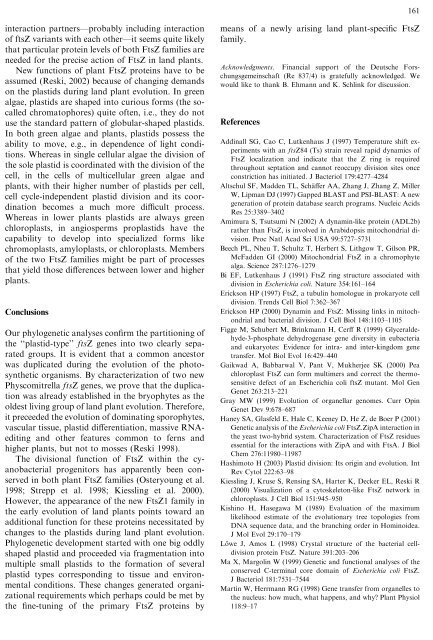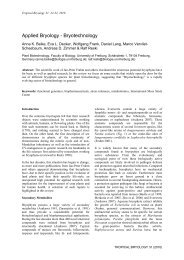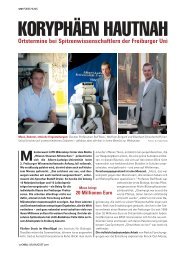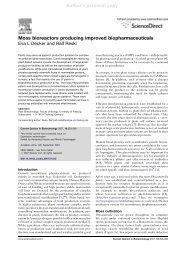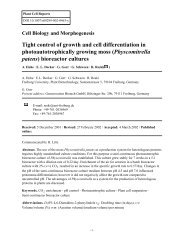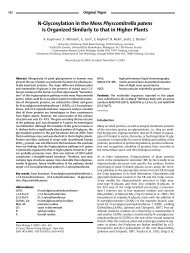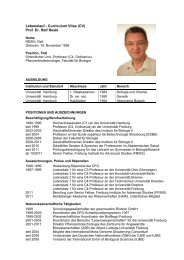Diversification of ftsZ During Early Land Plant Evolution
Diversification of ftsZ During Early Land Plant Evolution
Diversification of ftsZ During Early Land Plant Evolution
Create successful ePaper yourself
Turn your PDF publications into a flip-book with our unique Google optimized e-Paper software.
161<br />
interaction partners—probably including interaction<br />
<strong>of</strong> <strong>ftsZ</strong> variants with each other—it seems quite likely<br />
that particular protein levels <strong>of</strong> both FtsZ families are<br />
needed for the precise action <strong>of</strong> FtsZ in land plants.<br />
New functions <strong>of</strong> plant FtsZ proteins have to be<br />
assumed (Reski, 2002) because <strong>of</strong> changing demands<br />
on the plastids during land plant evolution. In green<br />
algae, plastids are shaped into curious forms (the socalled<br />
chromatophores) quite <strong>of</strong>ten, i.e., they do not<br />
use the standard pattern <strong>of</strong> globular-shaped plastids.<br />
In both green algae and plants, plastids possess the<br />
ability to move, e.g., in dependence <strong>of</strong> light conditions.<br />
Whereas in single cellular algae the division <strong>of</strong><br />
the sole plastid is coordinated with the division <strong>of</strong> the<br />
cell, in the cells <strong>of</strong> multicellular green algae and<br />
plants, with their higher number <strong>of</strong> plastids per cell,<br />
cell cycle-independent plastid division and its coordination<br />
becomes a much more difficult process.<br />
Whereas in lower plants plastids are always green<br />
chloroplasts, in angiosperms proplastids have the<br />
capability to develop into specialized forms like<br />
chromoplasts, amyloplasts, or chloroplasts. Members<br />
<strong>of</strong> the two FtsZ families might be part <strong>of</strong> processes<br />
that yield those differences between lower and higher<br />
plants.<br />
Conclusions<br />
Our phylogenetic analyses confirm the partitioning <strong>of</strong><br />
the ‘‘plastid-type’’ <strong>ftsZ</strong> genes into two clearly separated<br />
groups. It is evident that a common ancestor<br />
was duplicated during the evolution <strong>of</strong> the photosynthetic<br />
organisms. By characterization <strong>of</strong> two new<br />
Physcomitrella <strong>ftsZ</strong> genes, we prove that the duplication<br />
was already established in the bryophytes as the<br />
oldest living group <strong>of</strong> land plant evolution. Therefore,<br />
it preceeded the evolution <strong>of</strong> dominating sporophytes,<br />
vascular tissue, plastid differentiation, massive RNAediting<br />
and other features common to ferns and<br />
higher plants, but not to mosses (Reski 1998).<br />
The divisional function <strong>of</strong> FtsZ within the cyanobacterial<br />
progenitors has apparently been conserved<br />
in both plant FtsZ families (Osteryoung et al.<br />
1998; Strepp et al. 1998; Kiessling et al. 2000).<br />
However, the appearance <strong>of</strong> the new FtsZ1 family in<br />
the early evolution <strong>of</strong> land plants points toward an<br />
additional function for these proteins necessitated by<br />
changes to the plastids during land plant evolution.<br />
Phylogenetic development started with one big oddly<br />
shaped plastid and proceeded via fragmentation into<br />
multiple small plastids to the formation <strong>of</strong> several<br />
plastid types corresponding to tissue and environmental<br />
conditions. These changes generated organizational<br />
requirements which perhaps could be met by<br />
the fine-tuning <strong>of</strong> the primary FtsZ proteins by<br />
means <strong>of</strong> a newly arising land plant-specific FtsZ<br />
family.<br />
Acknowledgments. Financial support <strong>of</strong> the Deutsche Forschungsgemeinschaft<br />
(Re 837/4) is gratefully acknowledged. We<br />
would like to thank B. Ehmann and K. Schlink for discussion.<br />
References<br />
Addinall SG, Cao C, Lutkenhaus J (1997) Temperature shift experiments<br />
with an <strong>ftsZ</strong>84(Ts) strain reveal rapid dynamics <strong>of</strong><br />
FtsZ localization and indicate that the Z ring is required<br />
throughout septation and cannot reoccupy division sites once<br />
constriction has initiated. J Bacteriol 179:4277–4284<br />
Altschul SF, Madden TL, Scha¨ ffer AA, Zhang J, Zhang Z, Miller<br />
W, Lipman DJ (1997) Gapped BLAST and PSI-BLAST: A new<br />
generation <strong>of</strong> protein database search programs. Nucleic Acids<br />
Res 25:3389–3402<br />
Amimura S, Tsutsumi N (2002) A dynamin-like protein (ADL2b)<br />
rather than FtsZ, is involved in Arabidopsis mitochondrial division.<br />
Proc Natl Acad Sci USA 99:5727–5731<br />
Beech PL, Nheu T, Schultz T, Herbert S, Lithgow T, Gilson PR,<br />
McFadden GI (2000) Mitochondrial FtsZ in a chromophyte<br />
alga. Science 287:1276–1279<br />
Bi EF, Lutkenhaus J (1991) FtsZ ring structure associated with<br />
division in Escherichia coli. Nature 354:161–164<br />
Erickson HP (1997) FtsZ, a tubulin homologue in prokaryote cell<br />
division. Trends Cell Biol 7:362–367<br />
Erickson HP (2000) Dynamin and FtsZ: Missing links in mitochondrial<br />
and bacterial division. J Cell Biol 148:1103–1105<br />
Figge M, Schubert M, Brinkmann H, Cerff R (1999) Glyceraldehyde-3-phosphate<br />
dehydrogenase gene diversity in eubacteria<br />
and eukaryotes: Evidence for intra- and inter-kingdom gene<br />
transfer. Mol Biol Evol 16:429–440<br />
Gaikwad A, Babbarwal V, Pant V, Mukherjee SK (2000) Pea<br />
chloroplast FtsZ can form multimers and correct the thermosensitive<br />
defect <strong>of</strong> an Escherichia coli <strong>ftsZ</strong> mutant. Mol Gen<br />
Genet 263:213–221<br />
Gray MW (1999) <strong>Evolution</strong> <strong>of</strong> organellar genomes. Curr Opin<br />
Genet Dev 9:678–687<br />
Haney SA, Glasfeld E, Hale C, Keeney D, He Z, de Boer P (2001)<br />
Genetic analysis <strong>of</strong> the Escherichia coli FtsZ.ZipA interaction in<br />
the yeast two-hybrid system. Characterization <strong>of</strong> FtsZ residues<br />
essential for the interactions with ZipA and with FtsA. J Biol<br />
Chem 276:11980–11987<br />
Hashimoto H (2003) Plastid division: Its origin and evolution. Int<br />
Rev Cytol 222:63–98<br />
Kiessling J, Kruse S, Rensing SA, Harter K, Decker EL, Reski R<br />
(2000) Visualization <strong>of</strong> a cytoskeleton-like FtsZ network in<br />
chloroplasts. J Cell Biol 151:945–950<br />
Kishino H, Hasegawa M (1989) Evaluation <strong>of</strong> the maximum<br />
likelihood estimate <strong>of</strong> the evolutionary tree topologies from<br />
DNA sequence data, and the branching order in Hominoidea.<br />
J Mol Evol 29:170–179<br />
Lo¨ we J, Amos L (1998) Crystal structure <strong>of</strong> the bacterial celldivision<br />
protein FtsZ. Nature 391:203–206<br />
Ma X, Margolin W (1999) Genetic and functional analyses <strong>of</strong> the<br />
conserved C-terminal core domain <strong>of</strong> Escherichia coli FtsZ.<br />
J Bacteriol 181:7531–7544<br />
Martin W, Herrmann RG (1998) Gene transfer from organelles to<br />
the nucleus: how much, what happens, and why? <strong>Plant</strong> Physiol<br />
118:9–17


